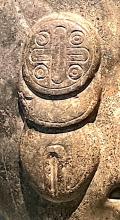coyolli (Mdz2r)
This element of a coyolli (bell, or little bell) has been carved from the compound sign for the personal name, Xocoyol. Here, we have included the red tie at the top that was attaching the bell to a person's lower leg. The bell is yellow. It has two horizontal stripes and a vertical slit/opening at the bottom, from which the sound would be emitted.
Stephanie Wood
The coyolli was not widely open at the bottom and did not have a hanging clapper inside. It was primarily closed, with a small opening at the bottom from which the sound would be emitted. Inside would be an object, such as a pellet, that would roll around, striking the sides and bottom of the bell, which would be hanging, as a rule. These bells resemble European hawks' bells more than church bells, and they fall into the European classifications of idiophone, shaken, rumble, or crotal bells. Perhaps hawks bells came from the Mexican model, as hawks' bells became popular in Spain during the sixteenth century (although perhaps before, and thus requiring further research. See Acacia Berry's article about bells in The History of Things (2018). In Nahua culture bells were often worn around the ankles with the intention of making music while dancing. Some bells were not made from metal at all, but from seed pods, and the like. But they were typically made of copper or a copper alloy, as shown in this 10th through 16th-century example in The Met, which provides a better view of the slit at the bottom and the hoop at the top that was intended for securing the bell to the ankle or to leggings, for example. Another Aztec cast copper bell at The Met shows an elaborate design on the exterior of the bell, and the metal has a greenish tarnish. The coyolli shown in this element from the Codex Mendoza is yellow, suggesting that the metal was gold. An example of Aztec jewelry at Dumbarton Oaks in Washington, D.C., includes gold bells. Also worthy of mention is the fact that the sacred female ancestor Coyolxauhqui wore bells in her hair, bells would typically appear on her cheeks to serve as signs for her name. In the carved example of the head of Coyolxauhqui in the National Museum of Anthropology in Mexico City, the bells on her cheek have a symbol above them that echoes our glyph for teocuitlatl) (gold).
Stephanie Wood
by 1553 at the latest
Stephanie Wood
Ed Trager
bells, campanas, campanillas, pinjantes, metales, gold, piel, rojo
coyolli.. A cheek ornament on a bust of Coyolxauhqui at the Museo Nacional de Antropología e Historia, Salón Mexica. The bell is suspended from something that appears to be engraved with the glyph for teocuitlatl, in this case suggesting that the ornament is fashioned out of gold. Photograph by Robert Haskett, 14 February 2023, who also wrote this commentary.

coyol(li), bell, little bell, https://nahuatl.wired-humanities.org/content/coyolli
bell, little bell
la campanita
Stephanie Wood
Codex Mendoza, folio 02 rectoo, https://codicemendoza.inah.gob.mx/inicio.php?lang=english
The Bodleian Libraries, University of Oxford, hold the original manuscript, the MS. Arch. Selden. A. 1. This image is published here under the UK Creative Commons, “Attribution-NonCommercial-ShareAlike 3.0 License” (CC-BY-NC-SA 3.0).


